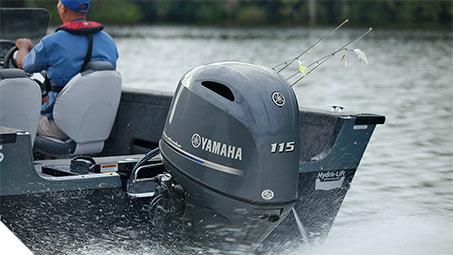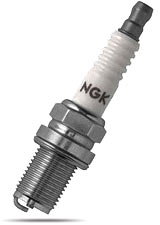Other Key Items
Water Pump.
 Your water pump is responsible for keeping your engine cool. It’s a simple system that works very well. Cooling water is drawn in through the intake grates on your lower unit, up to and through a rubber impeller keyed to the drive shaft on top of the lower unit, and pumped up into the powerhead of your outboard. There it circulates and eventually exits back down through the propeller to help keep it cool from the outboard’s exhaust. A telltale hole emits a small, visible stream of water after it has passed through the powerhead, to help indicate that cooling water is flowing.
Your water pump is responsible for keeping your engine cool. It’s a simple system that works very well. Cooling water is drawn in through the intake grates on your lower unit, up to and through a rubber impeller keyed to the drive shaft on top of the lower unit, and pumped up into the powerhead of your outboard. There it circulates and eventually exits back down through the propeller to help keep it cool from the outboard’s exhaust. A telltale hole emits a small, visible stream of water after it has passed through the powerhead, to help indicate that cooling water is flowing.
Tip: If water should stop flowing from the telltale hole on your outboard, or if the stream becomes weak, carefully check the outlet tubing for obstructions. Mud daubers and other insects love to call these places home, especially during periods of extended storage.
Tip: Not all outboards will emit waterflow from the telltale hole at idle speed, even when operating normally. Once RPM increases a bit, however, you should see it. If you don’t, keep a close watch on your temperature gauge and listen for a warning horn. Additionally, Yamaha outboards have an RPM reduction mode (as do most brands) which will limit the engine RPM if an overheat condition is detected.
Tip: The rubber impeller is located inside a stainless steel cup, and uses the water for lubrication. If this water is not present, the friction of the rubber on stainless steel will very rapidly overheat and destroy the rubber impeller. This is why it’s imperative NOT to operate, or even turn over, your outboard without there being a proper supply of water to the outboard beforehand.
Time without use can lead to the impeller “taking a set”, or becoming permanently deformed, due to its off-center positioning inside the cup. This condition makes water flow much weaker. Additionally, periods of non-use can cause the rubber to become more brittle, perhaps even breaking pieces off and sending them into the cooling system. For these reasons, it’s best to replace your water pump impeller or the entire water pump assembly when servicing these items, and never rotate your outboard’s crankshaft or driveshaft in a counterclockwise direction.
As a general rule, inspect the impeller and water pump assembly every year if operating in salt, brackish or turbid water, and replace if necessary. The debris in these waters acts like sandpaper. If operating in freshwater that is clear and clean, this interval may likely stretch to two seasons, provided no dry operation has occurred. Be sure to check your particular owner’s manual for your outboard’s specific service interval.
Tip: If you’re at all uneasy about performing impeller/water pump inspection and replacement procedures, have your local Yamaha Marine dealer do the work. They have the tools, materials and training to do it right, for your peace of mind.
Belts and Hoses.
Any belts and hoses your outboard has have to operate in the brutally harsh marine environment. Give them a glance once in a while, and heed the manufacturer’s schedule for their replacement. If you find cracking or fraying, be safe and replace. Do not attempt to “flip” a belt in order to extend its life, nor handle the belt with lubricant of any kind on your fingers. Keep these safe from spray-on lubricants, too.
Tip: Yamaha four-stroke outboard timing belts and HPDI® two-stroke outboard high-pressure fuel pump belts are cogged and Kevlar®-impregnated, making them super-tough and non-stretchable. Still, Yamaha recommends they be changed every five years or 1000 hours.
Spark Plugs.
 As a general rule, pull four-stroke outboard spark plugs every two hundred hours or every other season and check for proper color and wear. They should be a light brownish color and have relatively sharp edges. When necessary, replace with the exact manufacturer and part number that your outboard’s manufacturer stipulates. The brand type and style of spark plugs used in your outboard are by design. They contain specific performance attributes that are engineered into your outboard. Those little markings and numbers on your spark plugs contain a wealth of information about heat range, thread depth, etc.; so don’t second-guess or try to cross-reference here. Your outboard’s performance depends on it.
As a general rule, pull four-stroke outboard spark plugs every two hundred hours or every other season and check for proper color and wear. They should be a light brownish color and have relatively sharp edges. When necessary, replace with the exact manufacturer and part number that your outboard’s manufacturer stipulates. The brand type and style of spark plugs used in your outboard are by design. They contain specific performance attributes that are engineered into your outboard. Those little markings and numbers on your spark plugs contain a wealth of information about heat range, thread depth, etc.; so don’t second-guess or try to cross-reference here. Your outboard’s performance depends on it.
Thermostats and Pop-Off Valves.
These are responsible for regulating the operating temperature of your outboard. Simple and effective, they’re best observed through any signs of change in the engine’s operating temperature. Operating in saltwater can cause deposits to build up, causing the valves to stick open, which can over-cool the outboard and prevent it from reaching proper operating temperature. Small bits of debris in the cooling water can get lodged between mating surfaces and cause the same condition. If this happens, removal and cleaning is most often the fix. Check your owner’s manual for specific replacement recommendations.
Air Intake Passages.
Be sure to check the air intake passages for any obstructions such as bird nests and other debris brought in by various critters. Look under your cowling, too. It doesn’t take long for your outboard or boat to become home to local birds and bugs, and it can be a real headscratcher when it comes to performance-loss diagnosis.
